
Formation of Volcanic Caves

Lava tubes form in basaltic lava flows by two main processes:Other types of volcanic caves (non-tubes) also occur.
- by the roofing over of surface lava channels in several ways; and
- by the draining of still molten material from beneath the solidified crust of a flow.
The three figures illustrate the formation of a lava tube by the roofing over of a surface channel. The roof can form in several ways.Three ways of roofing a lava channel to form a lava tube.
Roofed channels are typically large, simple linear tubes, such as the big tunnels at Byaduk. However if the initial surface channel had several branches or a braided form then the resulting roofed tube will inherit this form. Also if smaller tubes have developed in overflows on the side of a channel these may remain connected to the master tube to produce a complex pattern. In the Natural Bridge at Mount Eccles the wall linings show convoluted layering which could have resulted from the downward slumping of the hot levee layers as they formed (see photos below). If the lava levels in a channel are fluctuating several roofs may form to produce a stacked multi-level tube.
(a) A solidified surface scum can accumulate and thicken until it is strong enough to form a roof. On a stationary or very slow moving flow the crust may form over the whole channel at once, but more usually it will begin to develop at the edges and progressively expand across the surface until it is entirely covered and then thickened from below. 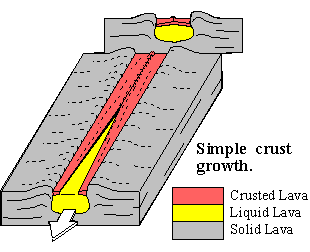
(b) With stronger or fluctuating flow rates, this initial crust may break up and the fragments be rafted downstream to accumulate as a 'log jam' that may be welded into a thick roof. 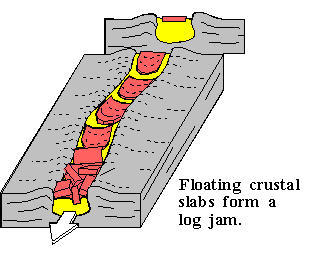
(c) Overflow or spatter can build up levee banks at the sides of the channel, and for narrow channels these may grow inwards as overhangs that eventually meet. This mode is probably responsible for the pointed 'gothic' roofs seen in some caves (e.g. Natural Bridge at Mount Eccles and at a small cave near Mount Napier). 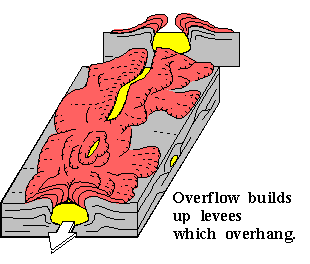


Entrance to Natural Bridge Cave,
Note "gothic" roof shapeContorted roof inside the cave,
indicating formation by lava levee overgrowth.
The figure below illustrates the formation of tubes by draining from beneath a crusted flow. The figure shows the case where a channel has overflowed, as along the Southern Canal at Mount Eccles, but similar effects occur at the front of an advancing pahoehoe lava flow where the lava is delivered by a channel or major feeder tube, but then spreads out into a series of lobes.
The lobes grow by a process of 'budding' in which a small lobe develops a skin, and is inflated by the lava pressure until the skin ruptures in one or more places. Lava escaping through the rupture develops new lobes and so on. If the supply of fresh lava is cut off, the still-liquid parts of a lobe may be drained out to leave a broad but low-roofed chamber. However, if fresh hot lava continues to be delivered from the volcano it may become concentrated into linear tubes that feed the advancing lobes, while the remaining stagnant areas slowly cool and solidify. These feeder tubes insulate the lava from cooling and can allow the flow to extend a considerable distance from its source.
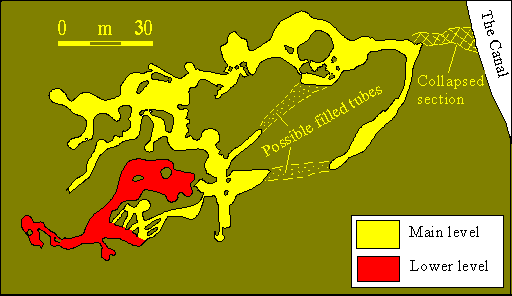
Map of a complex shallow tube system at Mt. Eccles resulting from drainage of lava lobes that overflowed from a lava channel.Tubes formed by draining of lava lobes and flows are generally smaller than those formed by the roofing of a channel. However, if flow continues after they are formed, several small tubes within a lobe complex may coalesce by breakdown of their thin walls or floors to form a larger feeder tube. Also, a continuing flow of hot lava through a small feeder tube can enlarge it by erosion of the walls or floor. Pahoehoe lobes can be stacked vertically as well as advance forwards so that a complex three-dimensional pattern of branching tubes forms. This may have happened in the Mount Hamilton Cave.
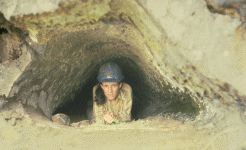
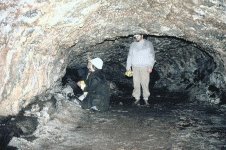
Typical small lava tube in drained lobe. Larger tube in drained lobe.
A few lava tubes have branching, multi-level forms of complex origin (for example, The Mount Hamilton tube and some caves at Byaduk). Complex branching and multilevel systems can evolve by a combination of several factors. The initial form may have been complex, as described above, or younger tubes can break through the ceiling of older tubes and re-occupy them. Blockages in a tube may force the lava upwards, to break out at the surface and form a new flow, which in turn will develop tubes. Stacked tubes can also result from the development of lava bridges formed when the tube was only partly filled. A flow within a tube may crust over and develop a smaller tube within it - a feature referred to as a ('tube-in-tube').The long lava flows in the region would all have been fed by large cylindrical lava tubes that continued to carry hot lava for tens of kilometres through the insulated core of a partly solidified flow. These long-lived feeder tubes are self modifying and destroy much of the evidence as to their original mode of formation. In a few places, as at Byaduk, the large feeder tubes have been partly drained and are now accessible through a set of large collapse dolines. These tubes have impressive domed cross sections up to 10 m high and 18 m wide.
The above discussion refers to the formation of lava-filled tubes. In any area only a small percentage of the tubes will be drained and accessible to cavers - most remain filled with solidified lava at the end of the eruption or are interrupted by solidified lava sumps in the lower parts (not recommended for cave divers!). See the map of Tunnel Cave at Mount Eccles for an example of a tube that is filled by solid lava at its present "end". Older open tubes may be buried by younger flows and become inaccessible.
[Top] [Home]Lava tubes are not the only type of cave that can form in volcanic rocks. A range of other volcanic cave types occur in the Newer Volcanics of Victoria. The diagram shows an explosive cavity and throat within a spatter cone that remained open after the volcanism ceased. The still open throat, 3m across, bells out into a volcanic chamber that is 23m deep and 24m across. Similar but smaller features called hornitos form by the venting of hot gases and minor spatter through a shaft connected to a lava tube. Several small caves have been reported in the scoria of the upper part of Mount Napier and at Mount Gambier- these are probably the result of erosion of the loose scoria from beneath a partly welded layer.
In the Stony Rises small caves form by the irregular draining of cavities beneath the crust of a broad lava flow. The process is similar to that which forms tubes in lava lobes (see above), but less organised so that only isolated low chambers appear to result. Commonly the chamber roof sags (while hot) or later collapses so that only a crescentic 'peripheral remnant cave' survives around the edge of a hollow. This type of single-chamber cave has previously been referred to as a 'blister cave' but that term is best restricted to chambers formed by gas pressure. Occasionally the still-liquid core of a tumulus may drain back down into the underlying flow to leave a small cave. One of the tumuli in the Harman Valley has a donut shape, resulting from the draining of its central core to form a cavity, followed by collapse of the roof.
Deep cracks develop in surface ridges or at edges of flows where the solid crust has either subsided or been pushed up. These can form small fissure caves.